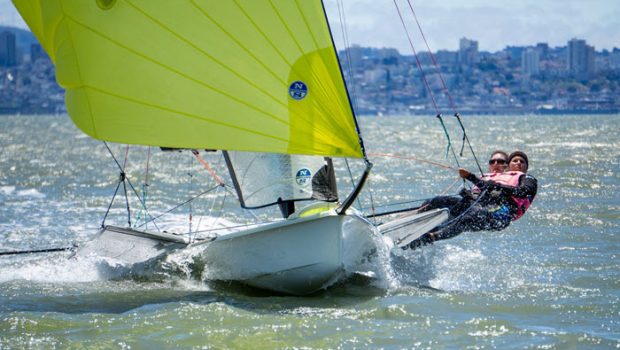Pushing past pitchpoles and wipeouts
Published on July 1st, 2021
The Skiff events at the Olympic Games are the hardest for new campaigners as laying a foundation of solid boat handling entails a lot of crash and burns. Tough on the body. Tough on the boats.
With its big wind and short chop, San Francisco Bay reveals weaknesses, so that’s where Lucy Wilmot and Erika Reineke went for their preparations toward the Paris 2024 Olympics. Here’s the latest update from this new 49erFX team:
Adrenaline pumping, spray blasting, and wind piping down through the Golden Gate was the daily forecast in June during our San Francisco training camp. Action packed with back to back breeze on days, we practiced at the pinnacle of extreme conditions.
Coming away with a hard drive full of pitchpole and wipeout highlights, we can confidently say we pushed the physical boundaries of heavy air sailing in the FX to learn what was achievable or unrealistic.
Unlike last summer, where we went out with the goal of surviving a day on the bay, our skill level had progressed to speed testing and mode matching on the upwinds. Each day was trial and error as we sought to grasp a better understanding of the rig and it’s overall influence on sail shape.
Before ever adjusting the rig, we got into the habit of asking ourselves, “What is the sail profile we are looking for and how do we want the boat to react through the water?”
An example of this is windy, flat water sailing. In this condition, we are looking for a depowered sail with a flat midsection and twist opening the top. This set-up should make the boat feel like carving through soft butter as the bow planes over the water surface.
In the skiff, there are multiple options to choose from when it comes to generating sail shape. The inventive part is deciding which setting or control line we are going to adjust to achieve a specific look. Imagine the rig as a rod with three-dimensional movement and mast bend regulated at different sections.
Going back to the previous example, if the conditions are windy and flat, we can move the caps up and tighten the primaries. This bends the mast back and causes the top to bend off initiating sail twist. Seeking a flatter midsection in sail shape, spinning the lower turnbuckles off and vanging against the mast is an option.
Furthermore, the cunningham, outhaul, centerboard height, jib tack, and car position also fine-tune sail shape and how the boat responds. Once the boat feels alive beneath our feet, much of these fine-tuning decisions evolve around the mainsheet range.
Photographs and videos of our speed testing line-ups have been extremely helpful in putting a “name to a face.” During the debrief, we can visualize sail shape at a specific setting and monitor its evolution as we change the rig. With each alteration, different options are presented in designing the ideal sail profile for a given condition.
Time-stamping every rig modification and capturing a picture of these changes has given us a more holistic view of rig tune. Once looking at sail curvature through a narrow lens, we are now beginning to see it as a blank canvas with potential.
San Francisco is a venue that always keeps a sailor honest. No matter how many days you have been on the bay, sailing here never quite feels totally “comfortable.” With each mistake, we often pay the highest price with a capsize. Yet, enduring a vast amount of wipe-outs and escaping the angel of death through a few hairy maneuvers, our confidence grew. Nearing the end of the camp, the boat felt reactive and the pace was on.
The icing on the cake was executing top level maneuvers on the margin in 20+ knots of wind. Thrilled with our progress, in the final days of training we decided to bring our ingenuity to the table and try a few new gybing tricks we had brainstormed together the night before; our commitment to be on the forefront of innovation remains steadfast no matter how many pitchpoles we must face to gain an advantage.
Mid-month, we traveled to Fort Lauderdale for the Gold Star Sailing Camp. There we spent two days coaching and getting to know some incredible individuals. The camp brought teenagers of fallen service members together to enjoy a week of sailing at the Lauderdale Yacht Club. Our team was honored to teach sailing and form bonds with these amazing kids.
In 48 hours, we provided an introduction to sailing, hung out on the sandbar, and nearly escaped a thunderstorm. It was a special experience to share the sport we love with them. We are grateful for the opportunity to give back to the families who made the ultimate sacrifice for our liberties and country.
Wrapping up June and less than a month to the start of the 2021 Olympic Games, we are so excited to see many of our teammates finally head over to Tokyo! We are unbelievably proud of their hard work and resiliency. We cannot wait to cheer them on from home. GO USA!
This month, our team will be featured in the St. Francis Yacht Club’s Wednesday Yachting Luncheon on July 7th, 12:00pm PDT. During the presentation, we will provide an update of our current campaign efforts and give you all the insider scoop on our approach to data analytics training. To watch this online presentation, click here.
For more from this team: https://www.wilmotreinekefx.com/
Tokyo 2020 Olympic Sailing Program
Men’s One Person Dinghy – ILCA 7
Women’s One Person Dinghy – ILCA 6
Men’s Two Person Dinghy – 470
Women’s Two Person Dinghy – 470
Men’s Skiff – 49er
Women’s Skiff – 49erFx
Men’s One Person Dinghy Heavy – Finn
Men’s Windsurfing – RS:X
Women’s Windsurfing – RS:X
Mixed Multihull – Nacra 17
Original dates: July 24 to August 9, 2020
Revised dates: July 23 to August 8, 2021









 We’ll keep your information safe.
We’ll keep your information safe.